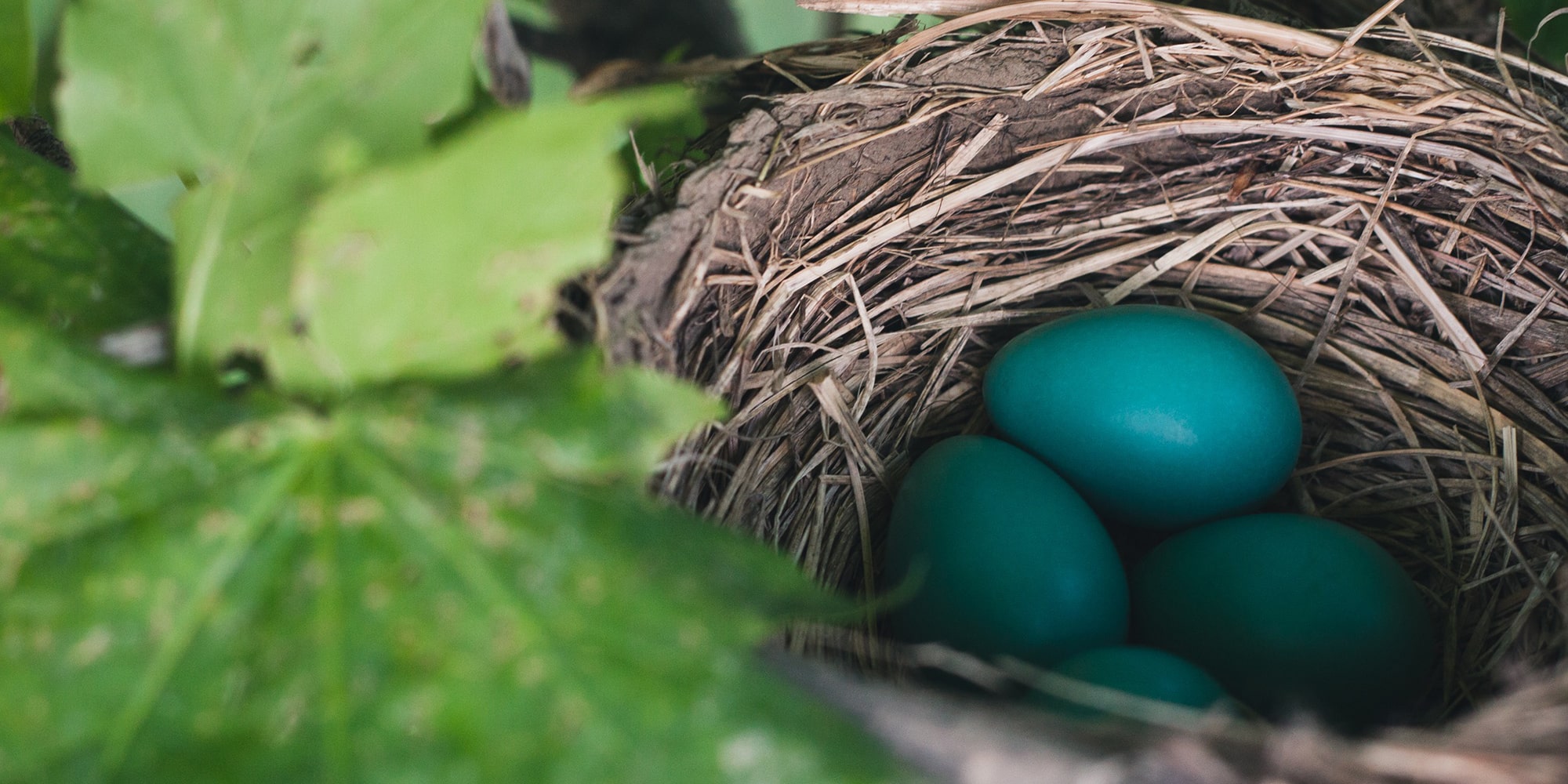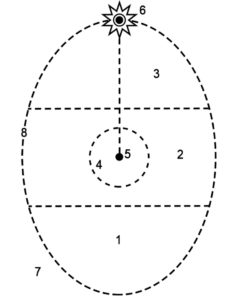
Symbolic meanings of the “egg” diagram
WATCH THE VIDEO (YouTube)
(in Italian with English translation)
“In alchemy the egg stands for the chaos apprehended by the artifex, the prima materia containing the captive world-soul. Out of the egg – symbolised by the round cooking vessel – will rise the eagle or phoenix, the liberated soul (…).”
Jung, 1968 (p. 202)
Psychosynthesis considers symbols as superior vessels for knowledge, bridging imagination, thought and intuition. I believe that the deeper meaning of Assagioli’s diagram may be better understood in light of its symbolic significance. Indeed, the egg shape used to represent our bio-psychospiritual wholeness is rich in hidden meanings.

- Lower unconscious
- Middle unconscious
- Higher unconscious
- Field of consciousness
- Conscious I (or personal self)
- Transpersonal Self
- Collective unconscious
- Biopsychic membrane (individual boundaries)
In all cosmogonies, the egg is an image and model of wholeness. In eastern philosophies (Hinduism, Buddhism and Taoism), the theme of the primordial egg is closely linked to the idea of the Great One, the principle of non-duality in which life’s intrinsic opposition between becoming and non-becoming, is simultaneously synthesised.
If, on the one hand, the egg symbolises the One beyond the dichotomy of being/non-being, on the other hand, it also represents genesis and revelation (Amariu, 1988, p. 8). In symbolic language, it is linked to the idea of fertile chaos. The cosmic egg is One, and at the same time, it contains Heaven and Earth, the lower and higher waters, yin and yang: the whole range of existential possibilities and multiplicity of beings.
In Alchemy, the symbolism of the egg relates to the vessel, the container in which transmutation takes place. The athanor, the alchemists’ furnace, was customarily compared to the cosmic egg due to its shape and above all, to its role as matrix and vessel of all transmutation. C. G. Jung (Jung, 1968, p. 202) provides an excellent summary of the symbolic links between the Egg and the Alchemical Opus: “In alchemy the egg stands for the chaos apprehended by the artifex, the prima materia containing the captive world-soul. Out of the egg – symbolised by the round cooking vessel – will rise the eagle or phoenix, the liberated soul.”
Other authors (Bonacina, unpublished notes, and Parfitt, 1997) suggest a further and evocative reading key, overlaying the symbol of the egg to that of the tree, especially the tree of life. The kabbalah sees in the tree the image of the human being and there doubtlessly is an analogy between Assagioli’s conception of psychic life and the kabbalists’ vision of the sephirot tree.
We find similar symbolic associations across cultures: the plant that is born, grows and dies is, in fact, universally regarded as the symbol par excellence of the human being. All the main interpretations of this symbolic theme circulate around the idea of a living cosmos, constantly regenerating. In this sense, the tree represents life in its dynamism. Stretched between the heavens and the underworld, the tree connects the three levels of the cosmos: the underground, with its subterranean roots digging deep into the earth; the surface, with its trunk and lower branches; and the skies, with its higher branches and sun-kissed crown. The birds of the sky resting upon its branches are the superior states of being. How could the analogy with the Psychosynthesis Egg diagram be anything but inescapable?
Having considered the possible symbolic meanings of the Egg Diagram, we may conclude that what may at first appear as a simplistic and static “topography” of the psyche, could best be viewed as a mandala, a symbol whose psychagogic function hints at the more evolutionary and dynamic aspects of the inner life.
For more:
- The Way of Psychosynthesis, Synthesis Insights (Part 3, Ch. II, pp. 165-168) – Buy now
“In alchemy the egg stands for the chaos apprehended by the artifex, the prima materia containing the captive world-soul. Out of the egg – symbolised by the round cooking vessel – will rise the eagle or phoenix, the liberated soul (…).”
Jung, 1968 (p. 202)
Psychosynthesis considers symbols as superior vessels for knowledge, bridging imagination, thought and intuition. I believe that the deeper meaning of Assagioli’s diagram may be better understood in light of its symbolic significance. Indeed, the egg shape used to represent our bio-psychospiritual wholeness is rich in hidden meanings.

- Lower unconscious
- Middle unconscious
- Higher unconscious
- Field of consciousness
- Conscious I (or personal self)
- Transpersonal Self
- Collective unconscious
- Biopsychic membrane (individual boundaries)
In all cosmogonies, the egg is an image and model of wholeness. In eastern philosophies (Hinduism, Buddhism and Taoism), the theme of the primordial egg is closely linked to the idea of the Great One, the principle of non-duality in which life’s intrinsic opposition between becoming and non-becoming, is simultaneously synthesised.
If, on the one hand, the egg symbolises the One beyond the dichotomy of being/non-being, on the other hand, it also represents genesis and revelation (Amariu, 1988, p. 8). In symbolic language, it is linked to the idea of fertile chaos. The cosmic egg is One, and at the same time, it contains Heaven and Earth, the lower and higher waters, yin and yang: the whole range of existential possibilities and multiplicity of beings.
In Alchemy, the symbolism of the egg relates to the vessel, the container in which transmutation takes place. The athanor, the alchemists’ furnace, was customarily compared to the cosmic egg due to its shape and above all, to its role as matrix and vessel of all transmutation. C. G. Jung (Jung, 1968, p. 202) provides an excellent summary of the symbolic links between the Egg and the Alchemical Opus: “In alchemy the egg stands for the chaos apprehended by the artifex, the prima materia containing the captive world-soul. Out of the egg – symbolised by the round cooking vessel – will rise the eagle or phoenix, the liberated soul.”
Other authors (Bonacina, unpublished notes e Parfitt, 1997) suggest a further and evocative reading key, overlaying the symbol of the egg to that of the tree, especially the tree of life. The kabbalah sees in the tree the image of the human being and there doubtlessly is an analogy between Assagioli’s conception of psychic life and the kabbalists’ vision of the sephirot tree.
We find similar symbolic associations across cultures: the plant that is born, grows and dies is, in fact, universally regarded as the symbol par excellence of the human being. All the main interpretations of this symbolic theme circulate around the idea of a living cosmos, constantly regenerating. In this sense, the tree represents life in its dynamism. Stretched between the heavens and the underworld, the tree connects the three levels of the cosmos: the underground, with its subterranean roots digging deep into the earth; the surface, with its trunk and lower branches; and the skies, with its higher branches and sun-kissed crown. The birds of the sky resting upon its branches are the superior states of being. How could the analogy with the Psychosynthesis Egg diagram be anything but inescapable?
Having considered the possible symbolic meanings of the Egg Diagram, we may conclude that what may at first appear as a simplistic and static “topography” of the psyche, could best be viewed as a mandala, a symbol whose psychagogic function hints at the more evolutionary and dynamic aspects of the inner life.
For more:
- The Way of Psychosynthesis, Synthesis Insights (Part 3, Ch. II, pp. 165-168) – Buy now
